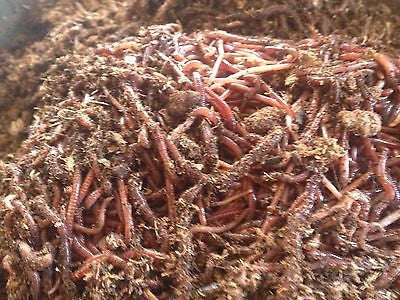Premium High Quality Red Wiggler Worms - Improve Your Yard's Fertility
Premium High Quality Red Wiggler Worms - Improve Your Yard's Fertility
Blog Article
Red Wiggler Worms Demystified: Opening the Keys of Vermiculture for Greener Living and Nutrient-Rich Dirt
In the realm of sustainable practices for enhancing soil quality and advertising eco-conscious living, red wiggler worms play a critical yet commonly forgotten duty. Red Wiggler Worms. Recognizing the details of caring for these worms, maximizing their environment, and harnessing their spreadings can lead to a greener way of living and much healthier dirt for plants to prosper.
The Function of Red Wiggler Worms
Red Wiggler worms play an important role in composting systems by effectively breaking down natural issue right into nutrient-rich spreadings. These ravenous eaters consume a variety of natural materials, such as kitchen scraps, lawn waste, and paper products. As they feed, the worms' digestive processes damage down the raw material right into a fine, dark, and nutrient-dense material called worm spreadings or vermicompost.
The spreadings created by Red Wiggler worms are extremely useful for soil health and wellness and plant development. They are abundant in crucial nutrients like potassium, nitrogen, and phosphorus, which are vital for sustaining healthy and balanced plant advancement. Furthermore, worm spreadings have useful microbes and enzymes that help enhance dirt structure, rise water retention, and boost nutrient uptake by plants.
Advantages of Vermicomposting

It improves dirt framework, boosts dirt aeration, and boosts dirt dampness retention. Vermicompost also improves the soil with necessary nutrients like nitrogen, potassium, and phosphorus, advertising plant development and overall soil fertility.
In addition, vermicomposting supports lasting gardening methods by providing a all-natural and chemical-free alternative to synthetic fertilizers. Red Wiggler Worms. This ecologically friendly technique not just improves the dirt however additionally helps reduce reliance on hazardous chemicals, advertising a greener and more sustainable method of horticulture
Setting Up a Worm Container
When developing a worm container for vermicomposting, proper arrangement is essential to ensure the success of the composting process. The very first step in establishing a worm container is selecting an appropriate container. This can be a plastic container or wood box that offers enough space for the worms to walk around and has proper drainage openings to stop waterlogging. Next off, a bedding product such as shredded paper, cardboard, or coconut coir must be included in the container. This bed linens gives a comfortable setting for the worms and aids maintain wetness degrees.
After including the bed linen, present the red wiggler worms to the bin. The worms should then be useful content provided with food scraps such as fruit and veggie peels, coffee premises, and eggshells.
Consistently monitor the moisture degrees and temperature level in the worm bin to make certain optimal conditions for the worms. With correct setup and maintenance, the worm bin will properly convert organic waste right into nutrient-rich garden compost for your plants and garden.
Gathering Worm Spreadings
To efficiently gather nutrient-rich worm castings from your vermicomposting system, an organized harvesting approach is crucial. There are a few essential actions to follow to ensure a successful procedure when it comes time to harvest the worm spreadings. Stop including fresh food scraps to one side of the worm bin for a pair of weeks before collecting. This motivates the worms to migrate sideways with fresh bed linen and food, making it easier to scoop out the spreadings from the various other side.

Troubleshooting Common Issues
Identifying and dealing with common challenges that may arise throughout the vermicomposting procedure is crucial for maintaining a healthy and balanced and effective worm bin. Adding excess food scraps can lead to an accumulation of dampness and level of acidity in the worm container, possibly damaging the worms. An additional problem is undesirable smells emanating from the worm container.
Additionally, if the worm population is decreasing or the worms show up harmful, maybe as a result of environmental stressors such as extreme temperatures or pH read this levels. Keeping an eye on these variables and making required modifications is vital for the wellness of the worms. By fixing these common issues promptly, vermicomposters can make certain a smooth and successful vermicomposting procedure while keeping a growing worm populace.

Conclusion
Finally, red wiggler worms play a crucial role in vermiculture by breaking down natural issue right into nutrient-rich dirt. The advantages of vermiculture include greener living and improved soil high quality. Setting up a worm bin is necessary for effective vermiculture, and harvesting worm castings offers useful compost for gardening. By recognizing and repairing common problems, people can open the secrets of vermiculture for lasting living and much healthier soil.
As they feed, the worms' digestion procedures break down the organic issue into a fine, dark, and nutrient-dense material known as worm castings or vermicompost.
The castings created by Red Wiggler worms are very advantageous for dirt health and plant development. Adding excess food scraps can lead to a buildup of moisture and acidity in the worm bin, possibly damaging the worms.Furthermore, if the worm population is declining or the worms appear undesirable, it can be due to environmental stress factors such as extreme temperatures or pH degrees. Setting up find more info a worm container is crucial for effective vermiculture, and gathering worm spreadings offers important compost for horticulture.
Report this page